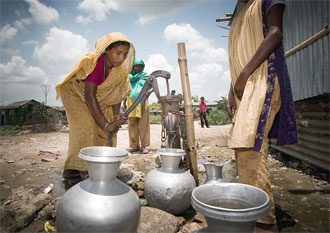
-
Subscribe to HDWQ Updates
Rebelmouse
-
Recent Posts
- Thank you for supporting WASHplus!
- Participatory workshop on water supply and treatment for developing communities
- Randomized Controlled Trial of Hospital Based Hygiene and Water Treatment Intervention to Reduce Cholera
- Zika virus infection in Mexico
- Solar-powered ATM delivers safe drinking water to Ugandan community
- SUWASA Pathway for Urban Water
- Household water treatment and safe storage – effectiveness and economics
- Innovative WASH interventions to prevent cholera
- Acceptability and Use of Portable Drinking Water and Hand Washing Stations in Health Care Facilities and Their Impact on Patient Hygiene Practices
- Morphology, composition and performance of a ceramic filter for household water treatment in Indonesia
- Perception of drinking water safety and factors influencing acceptance and sustainability of a water quality intervention in rural southern India
- Safe Water II – The paradigm shift in the approach to household water treatment systems
- Effectiveness of emergency water treatment practices in refugee camps in South Sudan
- Determinants of Caregivers’ Use and Adoption of Household Water Chlorination: A Qualitative Study with Peri-urban Communities in the Peruvian Amazon
- Coping with household water scarcity in the savannah today: Implications for health and climate change into the future
Archives
Categories
- Filtration-Charcoal (1)
- Hygienic Aspects (129)
- Water quality (76)
- Water storage (38)
- Treatment Methods (206)
- Aquatabs (1)
- Boiling Water (12)
- Charcoal (1)
- Chitosan (3)
- Chlorination (33)
- Filtration-Biochar (1)
- Filtration-Biosand (35)
- Filtration-Bucket (2)
- Filtration-Carbon (1)
- Filtration-Ceramic (38)
- Filtration-Char (3)
- Filtration-Mineral Pot (1)
- Filtration-Nanofilter (7)
- Filtration-Slow Sand (5)
- Flocculant/Disinfectant Powder (5)
- Lifestraw (2)
- Moringa oleifera (14)
- Nanotechnology (4)
- Sari-cloth (3)
- Solar Disinfection (SODIS) (43)
- Ultraviolet disinfection (4)
- Uncategorized (316)
Recent Comments
- Raine Jacob on Indigenous Water Filtration Technique in Rural Areas of Assam: A Study on Iron Removal by Bamboo Charcoals
- Sonia Mishra on Market potential analysis for water purifier using nanotechnology for the bottom of pyramid market
- Chris on What factors affect sustained adoption of safe water, hygiene and sanitation technologies?
- Rose Ojwang on Water Business Kit Kenya: A guide to starting your own water treatment and vending business
- Gabriele on Methods to Make Chlorine Solution in Ebola Emergencies
Tags
arsenic Bangladesh behavior change Cambodia carbon credits CAWST chlorine dispensers cholera diarrhea diarrheal disease diarrheal diseases Ecuador Ethiopia Ghana Haiti handwashing health impacts HIV/AIDS hygiene hygiene behavior India Indonesia Kenya Malawi Mali monitoring Nigeria Pakistan PATH Peru Rwanda sachet water South Africa sustainability Tanzania Uganda USAID Vietnam WASH in schools water carrying water quality water quality monitoring webinars willingness to pay ZambiaLinks
- Aquaya
- Centre for Affordable Water & Sanitation Technology (CAWST)
- Massachusetts Institute of Technology (MIT) – Safe Water
- PATH Safe Water Project
- Proctor & Gamble – Safe Drinking Water
- SafeWater System (SWS) – Centers for Disease Control & Prevention
- Silver Ceramic Systems
- SODIS – Solar Water Disinfection
- WASHplus
- WASHplus Innovation Exchange
- WASHplus/IRC Sanitation Updates
- WHO HWTS Network Presentations & Resources
Funded by

Implemented by

